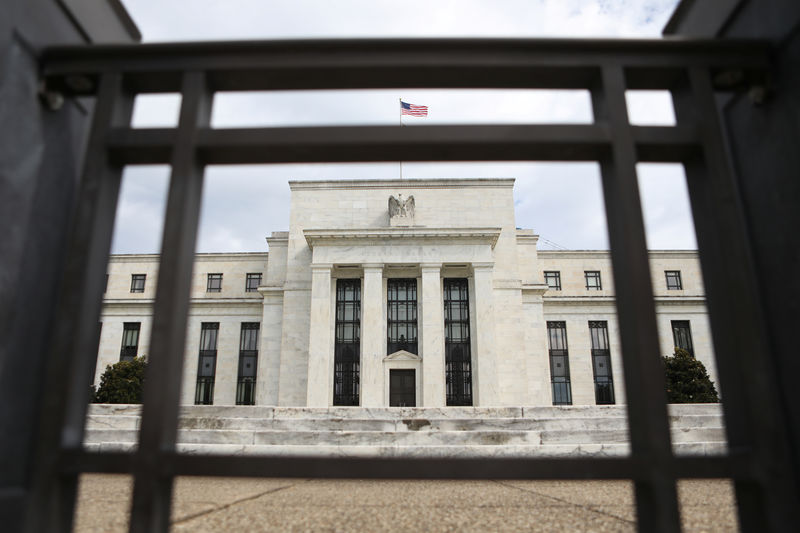(Bloomberg Opinion) -- One of the world’s most important interest rates has had a tumultuous week. Thanks to a sudden shortage of dollars in a separate market, the federal funds rate – the focal point of the U.S. Federal Reserve’s monetary policy – briefly breached the 2%-to-2.25% range that the central bank was targeting.
The aberration has generated a lot of concern. My advice: Don’t worry, the Fed can handle it.
Let’s start with what happened. The cash crunch occurred in a large and central piece of the financial system -- the “repo” market, where participants borrow and lend money against the collateral of various securities. Banks, hedge funds and other investors use it as a source of funds to buy U.S. Treasuries and other assets. Corporations and money-market funds use it as a safe place to park cash and earn a return.
Early this week, a confluence of events threw the repo market out of whack. First, until last month, the central bank had been paring down the securities portfolio it built up after the 2008 crisis, and this process had been soaking up the cash reserves that banks keep on deposit at the Fed. Second, a September 15 deadline for paying corporate taxes further depleted reserves. Finally, the settlement of a large Treasury auction created added demand for cash to pay for the government securities. When the cash flows into the Treasury’s account at the Fed, this drains reserves from the banking system. The imbalance of supply and demand caused repo rates to spike above 5% on Tuesday, more than double the level of the previous week. This, in turn, affected rates in the federal funds market, where banks lend reserves to one another.
The incident is not a harbinger of deeper market problems or a larger crisis. Rather, it provides a useful signal for the Fed, which has been seeking the right level of reserves for the smooth functioning of financial markets. For a long time, this wasn’t an issue: The Fed’s securities purchases, known as quantitative easing, had ensured that the supply of cash was always more than needed. Now, though, as the central bank has reduced its holdings, it’s discovering that various changes have increased the amount of reserves that banks want to hold. These include liquidity regulations, which require banks to hold more cash-like assets, and the Fed’s decision to pay interest on reserves, which makes it less costly for banks to leave cash parked at the central bank.
So what should the Fed do? It has a number of options, some of which will take longer than others to implement.
The primary short-term fix is what the Fed has already been doing: providing the cash that the market needs. Specifically, the New York Fed’s open market desk has increased the supply of reserves by lending money against securities in the repo market. This is one way that the desk can help ensure that the federal funds rate stays within its target range. The Federal Open Markets Committee in Washington D.C. sets the target, and the New York Fed is supposed to hit it. When this doesn’t happen, that’s a problem. I experienced this first hand when I was the System Open Market Account Manager during the financial crisis.
Another short-term fix is to reduce the rate that the Fed pays on reserves. On its own, this won’t address the imbalance in the repo market. But it will help prevent the pressure on repo rates from pushing the federal funds rate above the top end of the Fed’s target range. The Federal Open Markets Committee did this on Wednesday, when it lowered the interest rate on reserves by 0.30 percentage point - 0.05 percentage point more than it lowered its target for the federal funds rate.
One longer-term fix is for the Fed to boost its securities holdings more permanently, thereby increasing the supply of reserves to a level somewhat above the underlying demand from banks. Chairman Jerome Powell hinted at this on Wednesday, and I expect the central bank to announce something in the near future. There probably wasn’t sufficient time to prepare a detailed proposal this week, given that the pressure in the repo market wasn’t evident until Monday. And officials will have to communicate carefully, so the move won’t be confused with quantitative easing. Although the Fed’s balance sheet grows in both cases, the intent is completely different. To signal this, the Fed could focus on adding shorter-term obligations such as Treasury bills, as opposed to the longer-duration assets typically involved in QE.
Fourth, the Fed will likely consider a standing facility for the repo market – in which the central bank would stand ready to lend against Treasury or agency securities at a rate generally above the market and the federal funds target. This would provide a safety valve to mitigate upward pressure on repo rates. Fed officials have been exploring such a mechanism for some time. This week’s events should increase support for putting it in place.
